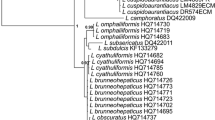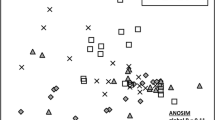Abstract
In the mountains of Veracruz State (east of Mexico), the southernmost limit of Fagus in the Americas, two relict forests of F. grandifolia var. mexicana were visited between 2007 and 2009 and 2013–2014, in order to study the ectomycorrhizal (EcM) systems of these trees with Lactarius rimosellus (L. subg. Russularia) and with L. acatlanensis (L. subg. Lactarius). We confirmed their EcM association through comparison of the internal transcribed spacer (ITS) of nuclear ribosomal DNA sequences from the mycobiont in the ectomycorrhizal systems and basidiomes sampled in the forest stands. The phytobiont in the ectomycorrhizae was also identified through the comparison of ITS sequences from EcM root tips and leaves of F. grandifolia var. mexicana. Detailed descriptions on the morphology and anatomy of EcM systems and microscopical features of mantle layers and Hartig net are presented and illustrated.






Similar content being viewed by others
References
Agerer R (1986) Studies on ectomycorrhizae II. Mycotaxon 26:473–492
Agerer R (1987–2002) Colour atlas of Ectomycorrhizae, vol 1–12 del. Einhorn-Verlag + Druck GmbH, Munich
Agerer R (2006) Fungal relationships and structural identity of their ectomycorrhizae. Mycol Prog 5:67–107. doi:10.1007/s11557-006-0505-x
Agerer R, Rambold G (2004–2016) DEEMY—an information system for characterization and determination of Ectomycorrhizae. (first posted on 2004-06-01; most recent update: 2015-02-03) http://www.deemy.de-München, Germany
Bâ AM, Duponnois R, Moyersoen B, Diédhiou AG (2012) Ectomycorrhizal symbiosis of tropical African trees. Mycorrhiza 22:1–29. doi:10.1007/s00572-011-0415-x
Bandala VM, Montoya L (2010) Lactarius fumosibrunneus in a relict Fagus grandifolia var. mexicana population in a Mexican montane cloud forest. Mycotaxon 114:333–342
Bandala VM, Montoya L, Ramos A (2016) Two new Lactarius species from a subtropical cloud forest in eastern Mexico. Mycologia 108:967–980
Becerra AG, Zack MR (2011) The ectomycorrhizal symbiosis in South America: morphology, colonization, and diversity. In: Rai M, Varma A (eds) Diversity and biotechnology of ectomycorrhizae. Soil biology, vol 25. Springer-Verlag, Berlin, p 459 pp 19–41
Burke DJ, Lopez-Gutierrez JC, Smemo KA, Chan CR (2009) Vegetation and soil environment influence the spatial distribution of root associated fungi in a mature beech-maple forest. Appl Environ Microbiol 75:7639–7648
Burlingham GS (1907) Some Lactarii from Windham County, Vermont. Bull Torrey Bot Club 34:85–95
Burlingham GS (1908) A study of the Lactariae of the United States. Memoirs of the Torrey Botanical Club 14:1–109
Buyck B, Hofstetter V, Verbeken A, Walleyn R (2010) Proposal to conserve Lactarius nom. Cons. (Basidiomycota) with a conserved type. Taxon 59:295–296
Comandini O, Erős-Honti Z, Jakucs E, Flores R, Leonardi M, Rinaldi A (2012) Molecular and morpho-anatomical description of mycorrhizas of Lactarius rimosellus on Quercus sp., with ethnomycological notes on Lactarius in Guatemala. Mycorrhiza 22:279–287
Dahlberg A, Jonsson L, Nylund JE (1997) Species diversity and distribution of biomass above and below ground among ectomycorrhizal fungi in an old-growth Norway spruce forest in south Sweden. Can J Bot 75:1323–1335
Eberhardt U (2002) Molecular kinship analyses of the agaricoid Russulaceae: correspondence with mycorrhizal anatomy and sporocarp features in the genus Russula. Mycol Prog 1:201–223
Garay-Serrano E, Bandala VM, Montoya L (2012) Morphological and molecular identification of the ectomycorrhizal association of Lactarius fumosibrunneus and Fagus grandifolia var. mexicana trees in eastern Mexico. Mycorrhiza 22:583–588
Gardes M, Bruns TD (1993) ITS primers with enhanced specificity for basidiomycetes application to the identification of mycorrhizae and rusts. Mol Ecol 2:113–118
Gardes M, Bruns TD (1996) Community structure of ectomycorrhizal fungi in a Pinus muricata forest: above- and below-ground views. Can J Bot 74:1572–1583
Gómez-Hernández M, Williams-Linera G (2011) Diversity of macromycetes determined by tree species, vegetation structure, and microenvironment in tropical cloud forests in Veracruz, Mexico. Botany 89:203–216
Haug I, Weiß M, Homeier J, Oberwinkler F, Kottke I (2005) Russulaceae and Thelephoraceae form ectomycorrhizas with members of the Nyctaginaceae (Caryophyllales) in the tropical mountain rain forest of southern Ecuador. New Phytol 165:923–936
Henkel TW (2003) Monodominance in the ectomycorrhizal Dicymbe corymbosa (Caesalpiniaceae) from Guyana. J Trop Ecol 19:417–437
Henkel TW, James TY, Miller SL, Aime MC, Miller OK Jr (2006) The mycorrhizal status of Pseudotulostoma volvata (Elaphomycetaceae, Eurotiales, Ascomycota). New Phytol 172:753–762
Henkel TW, Terborgh J, Vilgalys RJ (2002) Ectomycorrhizal fungi and their leguminous hosts in the Pakaraima Mountains of Guyana. Mycol Res 106:515–531
Hesler LR, Smith AH (1979) North American species of Lactarius. Univ. of Michigan, Ann Arbor
Hopple J, Vilgalys R (1999) Phylogenetic relationships in the mushroom genus Coprinus and dark-spored allies based on sequence data from the nuclear gene coding for the large ribosomal subunit RNA: divergent domains, outgroups and monophyly. Mol Phylogenet Evol 13:1–19
Hutchinson LJ (1999) Lactarius. In: Cairney JWG, Chambers SM (eds) Ectomycorrhizal fungi: key genera in profile. Springer-Verlag, Berlin, pp 269–285
Kress WJ, Erickson DL (2007) A two-locus global DNA barcode for land plants: the coding rbcL gene complements the non-coding trnH-psbA spacer region. PLoS One 2:e508
Lamus V, Montoya L, Aguilar CJ, Bandala VM, Ramos D (2012) Ectomycorrhizal association of three Lactarius species with Carpinus and Quercus trees in a Mexican montane cloud forest. Mycologia 104:1261–1266
Montoya L (2001) Estudio del género Lactarius Pers. (Fungi, Basidiomycotina, Russulales) en México, PhD thesis. Universidad de Alcalá, Spain
Montoya L, Ayala N, Bandala VM, Moreno G (1998a) Studies on Lactarius from Mexico: first report of L. rufulus. Documents Mycologiques 23:29–32
Montoya L, Bandala VM (2005) Revision of Lactarius from Mexico. Additional new records. Persoonia 18:471–483
Montoya L, Bandala VM (2008) A new species and new records of Lactarius (subgenus Russularia) in a subtropical cloud forest from eastern Mexico. A new species and new records of Lactarius (subgenus Russularia) in a subtropical cloud forest from eastern Mexico. Fungal Divers 29:61–72
Montoya L, Bandala VM (2011) A new Phylloporus from two relict Fagus grandifolia var. mexicana populations in montane cloud forest. Mycotaxon 117:9–18
Montoya L, Bandala VM, Garay E (2014) Two new species of Lactarius associated with Alnus acuminata subsp. arguta in Mexico. Mycologia 106:949–962
Montoya L, Bandala VM, Garay E (2015) The ectomycorrhizas of Lactarius cuspidoaurantiacus and Lactarius herrerae associated with Alnus acuminata in Central Mexico. Mycorrhiza 25:457–467
Montoya L, Bandala VM, Guzmán G (1996) New and interesting species of Lactarius from Mexico, including scanning electron microscope observations. Mycotaxon 57:411–424
Montoya L, Bandala VM, Haug I (2010) Two Lactarius species associated with a relict Fagus grandifolia var. mexicana population in a Mexican montane cloud forest. Mycologia 102:153–162
Montoya L, Bandala VM, Haug I, Stubbe D (2012) A new species of Lactarius (subgenus Gerardii) from two relict Fagus grandifolia var. mexicana populations in Mexican montane cloud forests. Mycologia 104:175–181
Montoya L, Bandala VM, Herrera S, Ortíz J (1998b) An interesting record of Lactarius from the Gulf and Caribe. Zeitschrift für Mykolologie 64:91–96
Moyersoen B (2006) Pakaraimaea dipterocarpacea is ectomycorrhizal, indicating an ancient Gondwanaland origin for the ectomycorrhizal habit in Dipterocarpaceae. New Phytol 172:753–762
Mueller GM, Schmit JP, Hubndorf SM, Ryvarden L, Oʼdell TE, Lodge DJ, Leacock PR, Mata M, Umañia L, Wu QF, Dl C (2004) Recommended protocols for sampling macrofubgi. In: Mueller GM, Bills GF, Foster MS (eds) Biodiversity of Fungi: inventory and monitoring methods, p 777. Elsevier Academic Press, San Diego, pp 106–172
O’Dell TE, Lodge DJ, Mueller GM (2004) Approaches to sampling macrofungi. In: Mueller GM, Bills GF, Foster MS (eds) Biodiversity of fungi. Inventory and monitoring methods. Elsevier Academic Press, San Diego, pp 163–168
Peay K, Kennedy PG, Brunns TD (2011) Rethinking ectomycorrhizal succession: are root density and hyphal exploration types drivers of spatial and temporal zonation? Fungal Ecol 4:233–240
Peay KG, Kennedy PG, Davies SJ, Tan S, Bruns TD (2010) Potential link between plant and fungal distributions in a dipterocarp rainforest: community and phylogenetic structure of tropical ectomycorrhizal fungi across a plant and soil ecotone. New Phytol 185:529–542
Peck CH (1906) Report of the state botanist, 1905. Bulletin of New York State Museum 105:5–106
Peintner U, Lotti M, Klotz P, Bonuso E, Zambonelli A (2007) Soil fungal communities in a Castanea sativa (chestnut) forest producing large quantities of Boletus edulis sensu lato (porcini): where is the mycelium of porcini? Environ Microbiol 9:880–889
Ponette-González AG, Weathers KC, Curran LM (2010) Tropical land-cover change alters biogeochemical inputs to ecosystems in a Mexican montane landscape. Ecol Appl 20:1820–1837
Pritsch K, Becerra A, Tedersoo L, Schloter M, Agerer R (2010) Description and identification of Alnus acuminata ectomycorrhizae from Argentinean alder stands. Mycologia 102:1263–1273
Rambaut A (2009) FigTree v1.2.3. Institute of Evolutionary Biology, Univ. of Edinburgh. http://tree.bio.ed.ac.uk/software/figtree
Rodríguez-Ramirez EC, Sánchez-González A, Ángeles-Pérez E (2013) Current distribution and coverage of Mexican beech forests Fagus grandifolia subsp. mexicana in Mexico. Endanger Species Res 20:205–216
Ronquist F, Teslenko M, van der Mark P, Ayres DL, Darling A, Höhna S, Larget B, Liu L, Suchard MA, Huelsenbeck JP (2012) MrBayes 3.2: efficient Bayesian phylogenetic inference and model choice across a large model space. Syst Biol 61:539–542. doi:10.1093/sysbio/sys029
Smith ME, Henkel TW, Aime MC, Fremier AK, Vilgalys R (2011) Ectomycorrhizal fungal diversity and community structure on three co-occurring leguminous canopy tree species in a Neotropical rainforest. New Phytol 192:699–712
Smith ME, Henkel TW, Uehling JK, Fremier AK, Clarke HD, Vilgalys R (2013) The ectomycorrhizal fungal community in a Neotropical forest dominated by the endemic dipterocarp Pakaraimaea dipterocarpacea. PLoS One 8:e55160. doi:10.1371/journal.pone.0055160
Smith AH, Hesler LR (1962) Studies on Lactarius, III The North American species of section Plinthogali. Brittonia 14:369–440
Tamura K, Stecher G, Peterson D, Filipski A, Kumar S (2013) MEGA6: molecular evolutionary genetics analysis version 6.0. Mol Biol Evol 30:2725–2729. doi:10.1093/molbev/mst197
Tedersoo L, May TW, Smith ME (2010) Ectomycorrhizal lifestyle in fungi: global diversity, distribution, and evolution of phylogenetic lineages. Mycorrhiza 20:217–263. doi:10.1007/s00572-009-0274-x
Tedersoo L, Sadam A, Zambrano M, Valencia R, Bahram M (2009) Low diversity and high host preference of ectomycorrhizal fungi in western Amazonia, a neotropical biodiversity hotspot. ISME J 4:465–471
Tedersoo L, Smith ME (2013) Lineages of ectomycorrhizal fungi revisited: foraging strategies and novel lineages revealed by sequences from belowground. Fungal Biol Rev 27:83–99. doi:10.1016/j.fbr.2013.09.001
Tedersoo L, Suvi T, Larsson L, Kõljalg U (2006) Diversity and community structure of ectomycorrhizal fungi in a wooded meadow. Mycol Res 110:734–748
White TJ, Bruns T, Lee S, Taylor J (1990) Amplification and direct sequencing of fungal ribosomal RNA genes for phylogenetics. In: Innis MA, Gelfand DH, Sninsky JJ, White TJ (eds) PCR protocols: a guide to methods and applications. Academic Press, New York, pp 315–322
Acknowledgements
We appreciate the assistance in the field and in the laboratory to Biols. D. Ramos and J.C. Corona (both at Instituto de Ecología, A.C.). We recognize the support given by CONACYT (CB 169172) to study the EcM fungi associated to Fagus grandifolia var. mexicana in the montane cloud forest of Central Veracruz and by the postdoctoral grant to A. Ramos. We recognize the support given by CONACYT (225382) to the Laboratorio de Presecuenciación, Red Biodiversidad y Sistemática, INECOL. Ing. Bertha Pérez at this lab aid in some molecular procedures.
Author information
Authors and Affiliations
Corresponding author
Ethics declarations
Disclosure
All the experiments undertaken in this study comply with the current laws of the country where they were performed.
Conflict of interest
The authors declare no conflicts of interest.
Rights and permissions
About this article
Cite this article
Montoya, L., Bandala, V.M., Ramos, A. et al. The ectomycorrhizae of Lactarius rimosellus and Lactarius acatlanensis with the endangered Fagus grandifolia var. mexicana . Symbiosis 73, 135–144 (2017). https://doi.org/10.1007/s13199-017-0489-0
Received:
Accepted:
Published:
Issue Date:
DOI: https://doi.org/10.1007/s13199-017-0489-0




